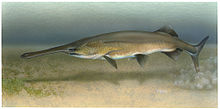
Back رماحيات Arabic سمكه مجدافيه ARZ Весланосыя Byelorussian Веслоноси Bulgarian Poliodòntids Catalan Polyodontidae CEB Löffelstöre German Polyodontidae Spanish Espatula arrain Basque پوزهپارویی Persian
| Paddlefishes Temporal range: [1]
| |
|---|---|

| |
| American paddlefish, Polyodon spathula | |

| |
| Chinese paddlefish, †Psephurus gladius | |
| Scientific classification | |
| Domain: | Eukaryota |
| Kingdom: | Animalia |
| Phylum: | Chordata |
| Class: | Actinopterygii |
| Order: | Acipenseriformes |
| Suborder: | Acipenseroidei |
| Family: | Polyodontidae Bonaparte, 1838 |
| Genera | |
|
Recent genera Fossil genera | |
Paddlefish (family Polyodontidae) are a family of ray-finned fish belonging to order Acipenseriformes, and one of two living groups of the order alongside sturgeons (Acipenseridae).[3][4] They are distinguished from other fish by their elongated rostra, which are thought to enhance electroreception to detect prey. Paddlefish have been referred to as "primitive fish" because the Acipenseriformes are among the earliest diverging lineages of ray-finned fish, having diverged from all other living groups over 300 million years ago. Paddlefish are almost exclusively North American and Chinese, both extant and in the fossil record.[5]
Eight species are known: six extinct species known only from fossil remains (five from North America, one from China),[2] one extant species, the American paddlefish (Polyodon spathula), which is native to the Mississippi River basin in the U.S., and the Chinese paddlefish (Psephurus gladius), declared extinct in 2022 following a 2019 recommendation;[6][7][8] the species has not been sighted in the Yangtze River Basin in China since 2003.[9][10] Chinese paddlefish are also commonly referred to as "Chinese swordfish", or "elephant fish".[11] The earliest known species is Protopsephurus from the Early Cretaceous (Aptian) of China, dating to around 120 million years ago.
Paddlefish populations have declined dramatically throughout their historic range as a result of overfishing, pollution, and the encroachment of human development, including the construction of dams that have blocked their seasonal upward migration to ancestral spawning grounds.[12] Other detrimental effects include alterations of rivers which have changed natural flows resulting in the loss of spawning habitat and nursery areas.[13]
- ^ Froese, Rainer; Pauly, Daniel (eds.). "Family Polyodontidae". FishBase. January 2009 version.
- ^ a b c Hilton, E. J.; During, M. A. D.; Grande, L.; Ahlberg, P. E. (2023). "New paddlefishes (Acipenseriformes, Polyodontidae) from the Late Cretaceous Tanis Site of the Hell Creek Formation in North Dakota, USA". Journal of Paleontology. 97 (3): 675–692. doi:10.1017/jpa.2023.19. S2CID 258095684.
- ^ Crow, K. D.; Smith, C. D.; Cheng, J. -F.; Wagner, G. P.; Amemiya, C. T. (2012). "An Independent Genome Duplication Inferred from Hox Paralogs in the American Paddlefish--A Representative Basal Ray-Finned Fish and Important Comparative Reference". Genome Biology and Evolution. 4 (9): 937–953. doi:10.1093/gbe/evs067. PMC 3509897. PMID 22851613.
- ^ "Paddlefish (Polyodon spathula)". tpwd.texas.gov. Retrieved 2022-12-02.
- ^ Wilkens, Lon A.; Hofmann, Michael H. (2007). "The Paddlefish Rostrum as an Electrosensory Organ: A Novel Adaptation for Plankton Feeding". BioScience. 57 (5): 399–407. doi:10.1641/B570505.
- ^ "Chinese Paddlefish and wild Yangtze Sturgeon extinct - IUCN". Reuters. 2022-07-22. Archived from the original on 23 July 2022. Retrieved 2022-07-22.
- ^ Zhang, Hui; Jarić, Ivan; Roberts, David L.; He, Yongfeng; Du, Hao; Wu, Jinming; Wang, Chengyou; Wei, Qiwei (2020). "Extinction of one of the world's largest freshwater fishes: Lessons for conserving the endangered Yangtze fauna". Science of the Total Environment. 710: 136242. Bibcode:2020ScTEn.710m6242Z. doi:10.1016/j.scitotenv.2019.136242. ISSN 0048-9697. PMID 31911255. S2CID 210086307.
- ^ "Study declares ancient Chinese paddlefish extinct". Oceanographic. 2020-01-09. Retrieved 2022-04-23.
- ^ "Chinese paddlefish, native to the Yangtze River, declared extinct by scientists". South China Morning Post. 2020-01-04. Retrieved 2020-01-04.
- ^ Qiwei, W. (2010). "Psephurus gladius". IUCN Red List of Threatened Species. 2010: e.T18428A8264989. doi:10.2305/IUCN.UK.2010-1.RLTS.T18428A8264989.en. Retrieved 11 November 2021.
- ^ Fisheries and Aquaculture Department. "Psephurus gladius (Martens, 1862)". Species Fact Sheet. Food and Agriculture Organization of the United States. Archived from the original on July 7, 2015. Retrieved June 10, 2014.
- ^ "Hooking the Dinosaur of Fish". The New York Times. 2018-05-26. ISSN 0362-4331. Retrieved 2018-05-27.
- ^ "Chinese Paddlefish". National Geographic. Archived from the original on July 14, 2014. Retrieved May 28, 2014.